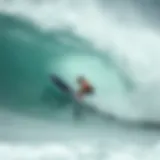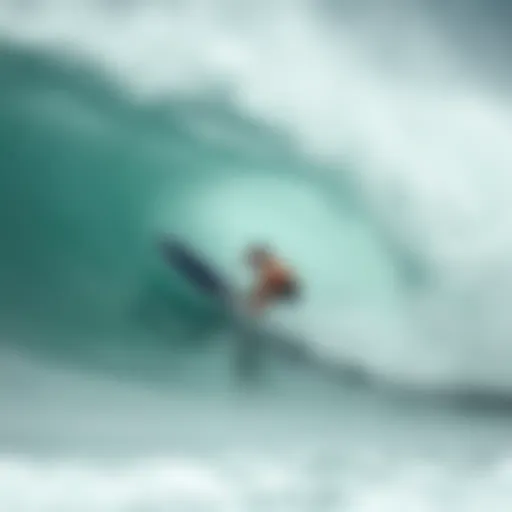Essential Guide to Kitesurfing Backpacks
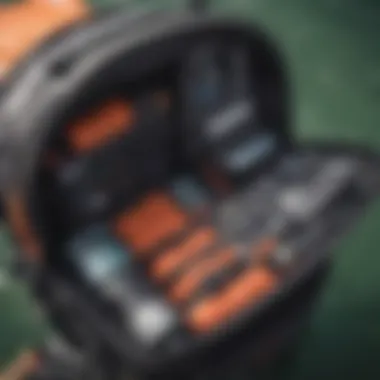

Intro
As kitesurfing gains traction around the world, the necessity for tailored gear becomes paramount. Among the critical elements of a successful kitesurfing outing is the kitesurfing backpack. It is not merely a bag; it’s a sanctuary for your gear, designed to keep everything organized, accessible, and secure. With the right backpack, you can seamlessly transition from travel to water. This guide aims to shed light on the essentials that make kitesurfing backpacks a must-have for anyone keen on this exhilarating sport.
Why a Specialized Backpack Matters
Kitesurfing involves diverse gear from kites and boards to harnesses and safety equipment. A typical duffel bag simply won't cut it. You need compartments that cater to the specific nature of your equipment. Imagine rummaging through a pile of wet wetsuits, only to find that your board leash has gone missing. A specialized kitesurfing backpack eliminates that stress, providing a place for everything and ensuring you can focus on the ride ahead.
Surf Gear and Equipment
In kitesurfing, quite like in sailing, gear is king. Let's dive into what gear you’ll need to consider when selecting the right kitesurfing backpack.
Latest Surfboard Technologies
Surfboards have come a long way, with advancements akin to those seen in aerodynamics and materials science. The emergence of hydrofoil boards, for instance, allows surfers to skim just above the water, letting them ride at high speeds even in light wind conditions. These boards are not only thrilling but require dedicated storage in a backpack that can accommodate their unique shapes.
In addition, materials like carbon fiber and epoxy resin have transformed traditional boards into lighter, more durable versions. When selecting a backpack, consider options that support such modern designs, with reinforced compartments to protect your gear during travel.
Essential Accessories for Surfers
Aside from the boards, there are myriad accessories that every kitesurfer ought to consider. Here’s a rundown of must-haves:
- Harness: A comfortable and secure harness is essential, as it connects you to your kite.
- Bar and Lines: This system controls the kite’s flight and must be well-organized in your backpack to avoid tangles.
- Wetsuit: Depending on the water temperature, you'll want an easily accessible wetsuit to maximize your time on the water.
- Safety Gear: Helmets and impact vests are crucial for safety, and a good backpack provides a spot to keep these items handy.
"A well-organized backpack can be the difference between a chaotic trip and a seamless, enjoyable day on the water."
Techniques and Skills
While your gear is crucial, the skills you bring to the table are equally important. Familiarizing yourself with various techniques will elevate your kitesurfing experience.
Wave Riding Strategies
It's not only about balancing; understanding the waves is key. Riding waves can be a symphony of movement and timing. Proper positioning and timing can allow surfers to use the wave’s push to their advantage, making for more exhilarating rides. Your pack's organization comes in handy here too; quick access to your gear might mean the difference between catching a wave or missing out.
Safety and Surf Etiquette
Kitesurfing is exhilarating but also comes with its risks. Safety is far from an afterthought. Knowing how to react in emergencies is as vital as mastering the tricks. Plus, understanding surf etiquette can save you—and others—quite a few headaches. From yielding to experienced riders to understanding wind and wave patterns, these soft skills often come in handy.
As we delve deeper into this guide, we will unpack the specific features of high-quality kitesurfing backpacks, their maintenance, and packing techniques that make a world of difference.
Stay tuned for more insights that are sure to reshape your approach to kitesurfing!
Understanding Kitesurfing Backpacks
Kitesurfing is gaining more traction as a thrilling watersport. It’s exciting and a bit of a dance with the elements, but the right gear is as crucial as skill with the kite. Amongst this gear, the kitesurfing backpack plays a vital role.
Defining the Kitesurfing Backpack
A kitesurfing backpack isn’t just any bag; it’s specifically designed to carry the unique gear related to the sport. These backpacks are not your run-of-the-mill daypacks. Rather, they come with robust padding, supportive straps, multiple compartments, and waterproof materials. A well-crafted kitesurfing backpack can accommodate kites, boards, and other essentials like harnesses and wetsuits without breaking a sweat.
For instance, many of these bags are engineered with a sleek, aerodynamic profile, making it easier to move around, especially if you're navigating rocky paths or muddy trails on your way to the beach. When choosing a backpack, it’s about more than just looks; you want something that's going to withstand the rigors of travel and rough handling.
Purpose and Necessity
The purpose of a kitesurfing backpack is fundamentally tied to safety and efficiency. A good backpack enables you to organize your gear effectively, allowing quick access when you’re gearing up. This becomes increasingly important when the wind is right and you need to hit the water without delay. Imagine fumbling around searching for your board handle when the wind is howling – it's not ideal.
Furthermore, having a designated backpack means you’re less likely to forget essential gear. A well-structured bag helps ensure you’re packing all the necessary items for your session. For example, specific compartments for small items like safety leashes or repair kits can save your day and keep your focus on enjoying the surf.
"An organized backpack is like a well-structured plan; it can make all the difference between a thrilling day on the water and a missed opportunity."
Additionally, the necessity of a kitesurfing backpack goes beyond personal convenience. As a community, kitesurfers tend to share a common ethos centered around respecting the environment. A quality backpack often features sustainable materials. This not only reinforces your commitment to preserving the beaches you love but also speaks to the increasing trend of eco-conscious choices within the sport.
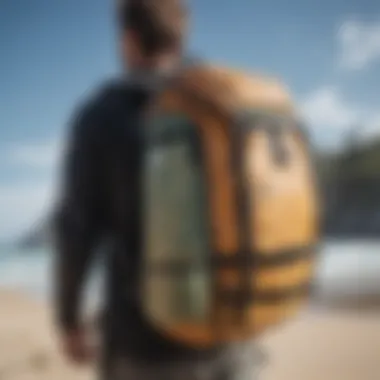

In essence, understanding kitesurfing backpacks encompasses recognizing their specialized design, functionality for storing vital gear, and their necessity in elevating your overall kitesurfing experience.
Key Features to Consider
When it comes to selecting a kitesurfing backpack, getting a handle on essential features is more than just shopping for looks. A kitesurfing backpack is not just any bag; it's a lifeline that holds everything you need for a safe and enjoyable adventure on the water. Understanding the key features can help both seasoned pros and newcomers alike make informed choices to enhance their kitesurfing experience.
Durability and Materials
One of the first things to think about is how tough the backpack is. Kitesurfing often puts gear through the wringer—sandy beaches, muddy paths, and the occasional drizzle can all take a toll. Look for backpacks made from durable, water-resistant materials like nylon or polyester. They resist wear and tear better than your average fabric. Remember, lighter materials add to comfort, but they shouldn’t come at the expense of strength.
For instance, consider the Gath Backpack, specifically designed with heavy-duty fabrics and reinforced seams. This kind of construction helps prevent rips, ensuring that your gear remains safe and secure.
"The best kitesurfing backpacks endure the elements, protecting your equipment while allowing you to navigate rough terrains effortlessly."
Compartments and Organization
Next in line is the matter of compartments and overall organization. A well-organized backpack can make packing and unpacking a breeze. Multiple pockets—not just a single big one—allow you to segment your gear. You could have one spot for your kite and another for your board. Additionally, smaller pockets are perfect for accessories like your harness, pump, or sunblock, so you're not sifting through layers of gear like looking for a needle in a haystack.
Many kitesurfing backpacks come with specialized compartments. These often include padded sections for delicate equipment to prevent damage. Look for backpacks with adjustable straps too, which can help when you’re in a rush or have packed in more than you originally planned.
Comfort and Fit
Never underestimate the importance of comfort and fit when kitesurfing for hours on end. A backpack that sits well on your back, distributes weight evenly, and minimizes strain is crucial. Padded shoulder straps may seem like a small detail, but they can make a world of difference, especially as the sun beats down.
Some backpacks even offer adjustable chest and waist straps. These features help keep everything snug, ensuring that the bag doesn’t bob around while you’re cruising along the beach or trekking to the perfect spot. If you’ve ever had a backpack dig into your shoulders or sway around while trying to walk, you’ll understand its essential nature.
In summary, selecting the right kitesurfing backpack hinges on durable materials, effective organization, and an ideal fit. Paying attention to these features will help ensure that your adventures are worry-free, making room for the thrills of kitesurfing rather than the nuisances of poorly designed gear.
Specialized Compartments
When it comes to kitesurfing backpacks, specialized compartments can make or break your on-water experience. These compartments serve a critical function, not just for organization but also for protecting your gear. In this section, we shall delve into what makes these compartments essential for any kitesurfer, from newbies to seasoned pros.
Storage for Kites and Boards
A well-structured kitesurfing backpack should provide designated storage for kites and boards. These are the heart and soul of your practice, so their protection is paramount. Many backpacks feature padded compartments specifically shaped for kites and boards, ensuring minimal movement during transit. This not only prevents potential damage from impacts but also keeps your gear free from scratches and dings.
When selecting a backpack, look for models with designated slots to separate kites and boards. Some designs even include specific straps or closures that hold boards securely in place, avoiding any unpleasant surprises when you reach your destination. Moreover, compartments should have weather-resistant features to protect your gear from rain or splashes. Opting for a backpack that emphasizes quality storage for kites and boards is wise, as it aligns with the principle that good gear means a better session.
Pockets for Accessories
Every kitesurfer knows it’s the little things that matter. Pockets for accessories are not just add-ons; they are mini command centers for your vital tools. From leash clips to pump nozzles and even sunscreen, a good backpack should have easily accessible pockets for these essential items.
In an adventure sport like kitesurfing, quick access can mean the difference between a smooth ride and a missed opportunity. Imagine setting foot on the beach only to realize that you can’t find your blade that keeps the kite in check! Look out for backpacks that offer multiple pocket types:
- Zippered pockets: Great for securing valuables like your phone or wallet.
- Mesh pockets: Perfect for items you want to keep handy but visible, like snacks or the aforementioned sunscreen.
- Stretch pockets: Handy for items that change in size, like a wetsuit.
Opting for a backpack with a solid array of accessory pockets makes your kitesurfing experience less stressful, allowing you to focus on what truly matters—having fun on the water.
Wet and Dry Storage Solutions
A day on the water often means dealing with wet gear. Backpacks that include wet and dry storage solutions can save you a lot of trouble later on. The ability to separate wet clothing or gear from dry items is a game changer. Imagine leaving the beach with your dry clothes intact, all because of your thoughtful backpack choice.
Some brands design backpacks with waterproof sections to house wet wetsuits, ensuring the rest of your gear remains dry. Waterproof zippers and water-resistant materials offer additional peace of mind. Likewise, look for ventilated pockets that help moisture escape without letting the stink in.
"Choosing a kitesurfing backpack with well-planned wet and dry storage is like finding the Holy Grail for water sports enthusiasts—it elevates the entire experience!"
Selecting the Right Kitesurfing Backpack
Choosing the right kitesurfing backpack isn’t just a minor detail; it’s a cornerstone of a successful and enjoyable kitesurfing experience. An excellent backpack serves not only as a carrier but as an essential part of your gear setup. It protects your equipment, helps in organization, and adds convenience on those wind-swept beach trips. In this ever-evolving sport where every piece of gear counts, being discerning in your selection can be the edge you need.
Aligning with Personal Needs
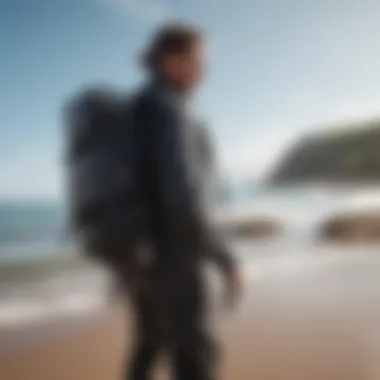

When it comes to kitesurfing gear, one size does not fit all. The perfect backpack for you hinges on your individual kitesurfing habits, the kind of gear you frequently carry, and even your travel style. First, consider the types of kites and boards you use. If you’re in it for freestyle tricks you might need a different setup compared to someone focused on wave riding. A larger bag with ample compartment space may make sense for freestyle, while a more streamlined design might suit wave riders who prefer moving light.
Additionally, think about the accessories and extras you carry along. Do you often pack a harness, spare lines, or even a wetsuit? These considerations demand a backpack with dedicated compartments that keep your items organized and easily accessible.
Comfort should also play a role in your decision. The right fit is critical, especially if you plan to trek across sand or rocky paths. Look for adjustable straps, padded back panels, and breathable materials that cater to long treks. Whether you're strolling to the beach or lugging gear to your car, your backpack should feel like a natural extension of yourself.
Evaluating Brand Options
With a multitude of brands on the market, narrowing down your choices might feel overwhelming. However, familiarity with reputable names can significantly ease your decision-making process. Investigate brands that specifically cater to kitesurfers since they understand the unique demands better than generic backpack makers. Brands like Naish, Airush, and Ride Engine have specialized backpacks designed with kitesurfing needs in mind.
It's prudent to read customer reviews and testimonials. A backpack may look spectacular on a website, yet user experiences often reveal its true strengths and weaknesses. Platforms like Reddit offer valuable insights and community recommendations.
Don’t overlook the warranty and post-purchase support offered. A brand that stands behind its product often showcases confidence, and warranties can be a lifesaver down the line if you encounter unexpected issues with your backpack.
Remember, selecting the right kitesurfing backpack is not just about aesthetics or ergonomics; it’s about creating a seamless connection between you and your exhilarating sport.
Packing Techniques for Kitesurfing Gear
Packing techniques play a pivotal role in ensuring that your kitesurfing experience is as seamless as possible. Kitesurfing involves a variety of gear, and organizing this equipment properly not only helps you to access everything you need but also minimizes the risk of damage to your valuable items. Arranging your gear with purpose can save you time and allows you to focus on the thrill of the ride rather than on searching for misplaced belongings.
When it comes to kitesurfing, a chaotic backpack can transform excitement into frustration in no time. Adequate packing techniques help to keep your kites, boards, and various accessories in good condition and ready for action. Here, we delve into two critical aspects of packing that will elevate your kitesurfing experience.
Optimal Packing Order
The order in which you pack your kitesurfing gear is significant. Starting from the heaviest to the lightest items generally is a sound strategy. It ensures that the weight is evenly distributed within your backpack, making it easier to carry. For instance:
- Kite: This is typically the largest item and should be packed first. Lay it flat in your backpack to prevent creasing.
- Board: Place the board next to the kite, if you can, as it provides an additional layer of protection for the fabric from the hard edges of the board.
- Harness: Slide the harness in a way that allows you to reach it without rummaging through your bag.
- Pumps and lines: These should be packed last, preferably in a separate pocket or compartment to keep them from tangling with other gear.
This order not only optimizes space but also minimizes the potential for damage to gear during transport.
Maximizing Space Efficiency
Another crucial aspect of packing is maximizing the space within your backpack. Not all backpacks are created equal, and knowing how to best utilize the available compartments can make a world of difference. Consider these practical tips:
- Roll, Don’t Fold: Rolling your clothing or other soft gear helps save space and reduce creasing. Think of it as packing like a burrito, where everything is snug and secure.
- Use Compression Bags: For clothes or items that require more space, consider using compression bags. These can significantly reduce bulk, making your backpack more manageable.
- Take Advantage of Zippers and Pockets: Most backpacks have hidden compartments. Use these cleverly for smaller items, ensuring nothing is lost in the shuffle. For example, mesh pockets are perfect for your sunscreen or other sensitive accessories that need ventilation.
- Distribute Weight Carefully: While you might be tempted to throw everything in one compartment, distributing the weight across all pockets creates better balance and less strain on your back.
"Packing efficiently is not just about space; it’s about peace of mind. Knowing exactly where each piece of gear is can make the difference between a smooth ride and a harried scramble."
By following these packing techniques, you'll not only enhance your overall experience but also extend the lifespan of your kitesurfing equipment, allowing for countless adventures on the water.
Maintenance and Care
Kitesurfing is not merely a sport; it’s a lifestyle. And for any serious kitesurfer, maintaining gear is as vital as actually hitting the waves. This rings especially true for kitesurfing backpacks, which bear the brunt of outdoor conditions—from salty ocean air to sandy beaches. Proper maintenance and care can vastly extend the life of your backpack, helping you avoid costly replacements and ensuring your gear remains ready for action.
Cleaning and Drying Techniques
Keeping your backpack clean goes beyond aesthetics. Salt, sand, and grime can lead to wear and tear if left unaddressed. Here’s a simple guide on how to maintain that pristine look and boost its longevity:
- Initial Shake: Just like shaking out a blanket, give your backpack a good flap outdoors. This will help dislodge any loose sand or debris after your day at the beach.
- Rinse: Use a hose or a bucket of fresh water to rinse off the exterior. Avoid harsh chemicals; typically, plain water does the trick.
- Soap and Sponge: If the grime persists, a mild soap mixed with fresh water can work wonders. Get a sponge, dip it in the solution, and scrub the spots needing extra attention.
- Drying: Once you've rinsed away the soap, it’s crucial to dry your backpack thoroughly. Leaving dampness can lead to mold or unpleasant odors. Turn the bag inside out and hang it in a shaded area to dry—too much sun can cause colors to fade.
- Storage: Lastly, when not in use, keep your backpack stored in a cool, dry place. Avoid cramming it in tight spaces, as that can lead to creases or even damaging the zippers.
Key Takeaway: A regular cleaning regimen not only maintains hygiene but also prevents the buildup of corrosive elements, ensuring your kitesurfing backpack holds up well over time.
Inspecting for Damage
A proactive way to keep your kitesurfing backpack in top shape is to regularly inspect it for damage. Keep an eye out for the following signs:
- Zipper Functionality: Test the zippers to ensure they run smoothly. If they snag, use a lubricant or check for trapped fabric.
- Fabric Wear: Give the fabric a thorough once-over for tears or thinning spots. Small holes can be patched promptly, but ignoring them could lead to larger rips.
- Strap Integrity: Check the straps and buckles regularly. They should feel secure and function without hesitation.
- Waterproofing: If your bag has water-resistant features, ensure that they are intact. Test by splashing some water on it to see if it beads off. If it doesn’t, consider reapplying a waterproofing spray made for fabrics.
- Interior Check: Don’t forget to empty your bag and inspect the lining. Sand or debris can find its way into pockets and zippers. Cleaning these areas helps keep everything in working order.
By routinely cleaning and inspecting your backpack, you not only extend its lifespan but also enhance your overall kitesurfing experience. After all, a happy backpack means a happy kiter.
Sustainability in Kitesurfing Gear


Sustainability is an increasingly significant consideration in today’s world, and kitesurfing gear is no exception. As the sport attracts more enthusiasts, the demand for environmentally friendly gear is rising. This segment delves into the importance of sustainable practices within kitesurfing, exploring the specific elements that make certain materials and companies stand out.
Eco-Friendly Materials
When it comes to kitesurfing backpacks, the materials used for construction play a crucial role in determining their environmental impact. Many traditional materials are derived from oil-based products, contributing to pollution and resource depletion. In contrast, eco-friendly materials aim to minimize environmental footprints.
Some notable options include:
- Recycled Polyester: Often sourced from discarded plastic bottles, making it both durable and sustainable.
- Hemp Fabric: Naturally grown without pesticides, hemp is a strong alternative that degrades without harm to the environment.
- Organic Cotton: While conventional cotton can require extensive irrigation and pesticides, organic cotton is grown in a more environmentally-friendly manner.
Using these materials can significantly reduce waste, resulting in a more sustainable approach to kitesurfing. Furthermore, adapting production processes to lower energy consumption and emissions is essential. By opting for these sustainable materials, kitesurfers contribute to a healthier planet.
Companies Committed to Sustainability
Several brands in the kitesurfing industry are leading the way in sustainability efforts. These companies not only prioritize eco-friendly materials in their products but also implement responsible practices across their overall operations.
For example:
- Ozone Kites: They integrate eco-friendly materials into their kites and backpacks while emphasizing ethical labor practices.
- North Kites: North has committed to transparency in its supply chain and utilizes recycled materials.
- Brunotti: They focus on reducing waste during production and offer a range of sustainable products.
These organizations help shape the industry by reminding consumers that purchasing decisions can affect environmental outcomes.
The shift towards sustainability is crucial; it not only ensures the continued enjoyment of kitesurfing but also sets a standard for future generations.
"Choosing eco-friendly gear today can create a lasting impact for tomorrow’s kitesurfers."
Exploring Pricing and Value
When it comes to kitesurfing backpacks, understanding pricing and value is crucial, especially for those who are determined to get the best gear without breaking the bank. It’s not just about finding the cheapest option; it’s all about striking that sweet spot where quality meets cost-effectiveness. The market doesn’t just offer a wide range of prices but also varies extensively in features, materials, and longevity. Thus, approaching the question of value means assessing how much use you're likely to get from your backpack against what you'll spend.
Budget Considerations
Setting a budget is paramount when you consider a kitesurfing backpack. It can often feel like a balancing act – weighing how much you’re willing to shell out against what you genuinely need. Here are some points to consider:
- Quality vs. Quantity: A lower price might attract you, but it could result in a hastily constructed bag. Think about spending a bit more upfront if it means your backpack will last longer.
- Durability Counts: Materials used in kitesurfing backpacks, like ripstop nylon or reinforced stitching, directly impact longevity. If a bag costs a bit more but has durable fabric, it might save you money in the long run.
- Functionality: The more features a backpack has, the more valuable it may become. For instance, if a backpack has specialized compartments for storage, that will help keep your gear organized and potentially protect it better.
- Brand Reputation: Some brands are known for producing reliable gear. Investing in such names could give you peace of mind, especially during those thrilling surf sessions where you want to make sure your equipment is secure.
By keeping these factors in mind, one can navigate the often murky waters of pricing more effectively. Remember, just because something is cheaper doesn't always mean it's a good deal.
Long-Term Investment Worthiness
Investing in a quality kitesurfing backpack shouldn't be seen through the lens of immediate expense alone. Consider it as an investment that pays off over time. Here are key aspects that underline the worthiness of such a purchase:
- Reduced Replacement Costs: When you buy a durable backpack, it should resist wear and tear. Cheaper backpacks may need replacing after a season or two, while sturdier options can last for years.
- Enhanced Performance: A well-made backpack can significantly improve your kitesurfing experience, making it convenient to carry equipment and keep it organized. This added efficiency allows you to focus more on your sessions.
- Resale Value: High-quality backpacks often hold their value better. If you decide to upgrade or shift to a different style, a well-maintained bag could fetch a decent price on resale platforms, recouping some of your initial investment.
- Peace of Mind: Knowing that your gear is stored securely can enhance your overall experience. Fear of equipment damage due to subpar storage solutions can ruin a session.
With all these factors in mind, you can approach your kitesurfing backpack selection with a strategic mindset, ensuring that every penny spent translates into an enjoyable and seamless surf experience.
Epilogue
The conclusion serves as a critical juncture in this comprehensive discussion on kitesurfing backpacks, encapsulating the key elements and insights laid out in the preceding sections. It is not merely a wrap-up; it solidifies the reader's understanding of how these backpacks significantly impact the kitesurfing experience. One cannot overstress the essence of selecting the right backpack, which goes well beyond aesthetics. Durability, material quality, and functional design contribute to a smooth surf adventure, ensuring that gear is well protected and easily accessible while on the water or moving between sites.
Moreover, a well-organized backpack can save kitesurfers both time and energy. Imagine unpacking at the beach and effortlessly locating your harness, board shorts, or sunscreen amidst a sea of disorganized gear. This ease can make or break a spontaneous trip, especially if reaching the perfect kitesurfing spot is a race against the setting sun.
Understanding maintenance and eco-friendly options adds another layer to the selection process. This not only ensures longevity of the gear but also reflects conscious choices favoring environmental sustainability. Thus, the backpack becomes a symbol of both practicality and ethical responsibility, crucial in today’s environment-conscious landscape.
Ultimately, making an informed choice about a kitesurfing backpack helps kitesurfers elevate their experience, allowing them to fully immerse in the adrenaline and thrill of their sport without unnecessary distractions. \n
"In the world of kitesurfing, the right equipment makes the ride. Let your backpack reflect what you love about the waves."
Recap of Essential Points
As we look back, here are the essential points that have been emphasized:
- Understanding the Purpose: Kitesurfing backpacks are specifically engineered to meet the demands of the sport, providing not just storage but also protection for gear.
- Key Features: When choosing a backpack, consider durability, organization, and comfort. These features ensure an efficient and enjoyable kitesurfing experience.
- Specialized Compartments: From holding kites and boards to designated pockets for accessories—these compartments enhance functionality.
- Maintenance is Key: Regular cleaning, drying, and inspecting for damages are vital for prolonging the life of your backpack.
- Eco-Friendly Choices: More kitesurfing brands are embracing sustainable materials, which benefits the environment and the sport’s image.
- Budgeting Wisely: It’s essential to evaluate the balance between cost and long-term benefits when selecting your backpack.
Final Recommendations
In making the right selection, consider a few practical recommendations:
- Assess your individual needs and kitesurfing style before investing in a backpack. Ask yourself:
- Don’t be afraid to test out different brands and styles. Comfort can be quite subjective, and you want one that fits you like a glove.
- Pay attention to reviews or discussions on forums like reddit.com where fellow kitesurfers share their experiences with various brands and models.
- Acknowledge that spending a bit more on quality could ultimately save you money in repairs or replacements down the road.
- Keep an eye on brands that prioritize sustainability in their products. Supporting eco-friendly companies not only aids the environment but fosters a market shift towards responsible manufacturing.
- Do you often travel with your gear?
- Are you mostly in the water or just at the beach?
By taking these points into account, not only will you choose a backpack that fits your needs, but you'll also enhance your overall kitesurfing experience and make better choices for yourself and the planet.














